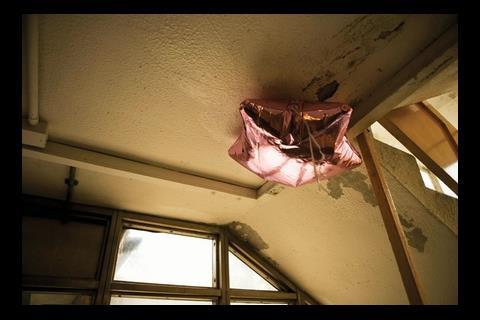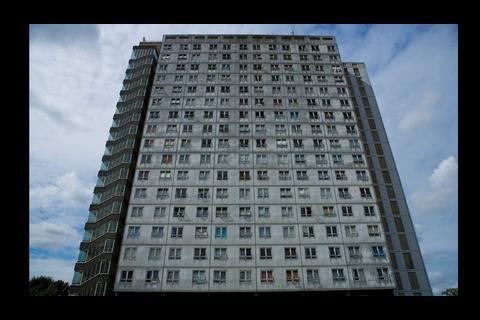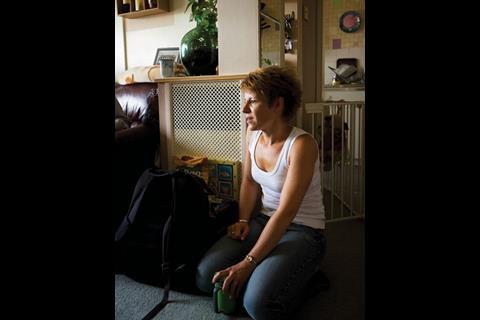Assessing the once mighty £21bn Decent Homes programme’s past achievements, and its increasingly uncertain future
This is one of 160,000 council properties that have had funding for refurbishment withdrawn as the government turns its attention to new building.
Kristee Potter was walking back to Chaucer House, her high-rise council block in Sutton, Greater London, with her toddler, Nathan, when some local boys pointed to it and said: “I wouldn’t even throw myself off that.”
It would be hard to think of a more succinct way of pointing out that the Decent Homes programme – the government’s £21bn, nine-year attempt to upgrade the country’s council housing stock – has plenty of unfinished business. Unfortunately, that work looks set to remain unfinished for some time to come. Last month, the communities department announced that funding for repairs to 160,000 homes in 13 councils would be diverted to new-build programmes.
Among those councils is Sutton, which makes Chaucer House an interesting starting point when considering the effects that this spending freeze will have – and whether the Decent Homes programme is the right approach anyway.
Chaucer’s tale
The appearance of the 45-year-old block where Kristee lives with her husband, Stuart, Nathan and daughter Leigh, is not the worst of it. Sometimes mysterious leaks appear in the building, trickling down the walls or pouring into the flat below. Finding the leak in the complicated, scissor-shaped block, can take hours.
Or the water can get into the ageing wiring system, blowing the fuse box and the lamps in the ceiling. The wiring system pre-dates fuses; whenever the circuit blows, the Potters have to become amateur electricians, fitting fuse wire into the ceramic sheaths – but none of the local shops sell fuse wire any more.
Sometimes Chaucer House’s flaws are just plain dangerous. A few years ago, Leigh returned from the upper floor saying the radiator was leaking. Stuart went up to have a look at the spraying pipe work and touched it, whereupon the whole unit fell from the wall, sending boiling water into the room. “I remember how, when the water hit Leigh’s crayons, they melted together in the Quality Street tin,” he says.
Even John Gallagher, Sutton council’s asset manager, admits it is the worst property in the borough. So Kristee was excited to hear about the £28m that Sutton Homes, the arm’s length management organisation (Almo) that manages the council’s housing stock, was due to receive over the next two years through the Decent Homes programme.
She joined the executive committee of the Sutton Federation of Tenants and Residents Associations to have more of a say over how the money would be spent. The funding was dependent on Sutton Homes obtaining a two-star rating from the Audit Commission. This rating reflects the Almo’s quality, service and financial planning. Sutton was expecting to get its two stars this autumn.
Gallagher planned to spend the money fixing problems including the wiring, paintwork, plumbing, heating and windows. He began tendering for contractors on four frameworks and ordering prefabricated bathrooms for houses that are full of asbestos. He estimates that he spent £250,000 on procurement before a contract had been signed. The price per unit was costed at £35,000.
We know what happened next. The communities department, in a drive to build 20,000 houses before the next election, “re-profiled” department spend and cut £150m of Decent Homes funding.
It said Almos that did not have a two-star rating would have to wait for at least two years before they got the money they were promised. Chaucer House will stay exactly as it is for at least the next two years, beyond a quick paint job in the lobby that the council is funding.
Past achievements
I remember how, when the water from the leaking radiator hit Leigh’s crayons, they melted together in the Quality Street tin
Stuart Potter, Chaucer house resident
The plight of tenants like the Potters becomes all the more galling when you consider that Decent Homes has, on the face of it, been a government success story. In 1997, four years before the programme started, there were 2.1 million homes that did not meet a decent standard. As of March last year, according to the communities department’s annual report, 82% of those – 1.7 million – had been bought up to decent standard. According to the Homes and Communities Agency (HCA), about £21bn has been spent on the programme. Cases like Chaucer House would appear to demonstrate an urgent need for that funding to continue if the government is to hit its revised target of transforming 95% of the country’s substandard homes by 2010.
The programme’s proponents can list its many incidental benefits. Paul Davies, group carbon manager at affordable housing contractor Wates Living Space, says the programme has given a push to the whole social housing industry from landlords to suppliers. “It had the ability to mobilise on a mass scale to deliver a programme of this type.”
Gwyneth Taylor, head of policy at the National Federation of Almos, points out that a significant requirement of Decent Homes funding is to deliver local labour and apprenticeships. Moreover, Almo boards must contain tenants. This, along with the requirement of a two-star rating, means the promise of Decent Homes money has acted as a carrot to councils to improve their game.
Taylor adds that studies from Sheffield University and Carrick Housing have proved that people living in decent homes have better mental and physical health, resulting in fewer referrals to GPs.
The right approach?
Yet the government is still unclear about how to take the programme forward and, while this uncertainty prevails, critics have been quick to point out some of the programme’s underlying weaknesses. Some look at cases like the Potters’ and question whether renovation is the answer at all.
Brendan Nevin is a partner at Nevin Leather Associates, and one of the inventors of the housing market renewal pathfinder scheme, which has led to redevelopment of thousands of houses in the North and Midlands. He says: “When demand wasn’t so extensive in northern England in the eighties and nineties, most of those similar properties were demolished.”
“London has got the worst-designed council social housing in the country. Decent Homes will have done nothing really to remedy the inherent faults in those buildings. It wasn’t an appropriate response.”
There is also criticism that the focus of the programme is entirely on the inside of flats. Paul Miller, partner at property and construction consultant Calford Seaden, says: “Hindsight is a wonderful thing but, looking back, Decent Homes limited itself too much to the fabric of the building. There wasn’t enough focus on local environmental improvements.
His firm is helping a registered social landlord make changes beyond the “front boundary” such as streetscape and path improvements. The money comes from a different funding stream, however.
“This is impossible to do with Decent Homes,” he says. “You are hamstrung.”
Joanne Roney, chief executive of Wakefield council and former housing director at Sheffield, raises a point made by others about the speed of the programme. “There was too much of a rush to get windows, doors and kitchens fitted by 2010,” she says. “It was a one-off capital investment rather than a continuing maintenance spend. We could have seen procurement and investment much more closely aligned rather than heading for a target spend.”
‘The carbon side of things’
There are also questions about the environmental benefits of Decent Homes. Richard Capie, head of policy at the Chartered Institute of Housing, says: “It’s one of the great success stories of modern housing policy. Having said that, if we’d known what we know now, we would have looked at the carbon side of things. We will look back at it with a bit of disappointment.”
Hindsight is a wonderful thing but, looking back, Decent Homes limited itself too much to the fabric of the building
Paul Miller, Calford Seaden
Both the Association for the Conservation of Energy and the World Wide Fund for Nature are lobbying to raise the energy efficiency standards of refurbishments (see box), but is lack of foresight a good enough excuse not to have addressed this before? After all, the programme was installing individual boilers at the same time as it was becoming clear that large-scale district heating was going to be the only way that the UK would meet carbon targets.
Moreover, the government established the Energy Saving Trust in 1993 and set a target for reducing UK emissions of carbon dioxide by 20% of 1990 levels by 2010. The climate change levy, which taxes the use of energy in industry, commerce and the public sector, encouraging improvements in energy efficiency, was introduced in 2001, the same year as the programme.
Wates Living Space’s Paul Davies says: “You could say the issue was one the government was aware of when Decent Homes was first dreamed up.”
Then there is the problem of energy efficiency’s evil twin, fuel poverty, which the government has pledged to wipe out by 2016. Some 3.75 million people currently live in fuel poverty, according to Ron Campbell, head of policy and information at National Energy Action. This is not much down from the 4.2 million in 1996.
While energy price hikes must shoulder most of the blame for this, Campbell says Decent Homes missed a trick in failing to set adequate standards of insulation. “When I read the proposed standards for insulation being 50mm loft insulation, I thought it was a misprint and missing the one. But it wasn’t. The aim is also for one central heat-producing unit and one other additional radiator. It’s absurd and risible.”
In fact, the Decent Homes guidance suggests that landlords should use 50mm as a starting point, but there is nothing to compel them to go above that number.
Defenders of the programme say these criticisms miss the point, however. Decent Homes was created to tackle specific and urgent issues. Nick Raynsford, who initiated the Decent Homes process as a minister at the then Department of the Environment, says the condition of council housing stock when Labour came into power was “appalling”.
“There had been chronic neglect and underinvestment for decades [and] urgent action was required. Decent Homes has brought about transformational change for a large number of people and has clearly been one of the most important elements in the housing programme.”
Paul Hackett, director of think tank the Smith Institute, who was an adviser to John Prescott as the programme was being unrolled, agrees, accusing those who would criticise it of a subtle form of snobbery. “The driver for Decent Homes was always improving the livelihood and quality of the homes of the people who lived in them – although it’s not captured the imagination of people who read the Guardian, it’s made a huge difference to people.”
What now?
The future of Decent Homes funding looks distinctly vulnerable, however, and alternative approaches to the UK’s council housing stock are being suggested.
David Lunts, London regional director for the HCA, set the ball rolling last week when he suggested to Building that Almos should make use of estate renewal funding –effectively echoing Nevin’s point that rebuilding is often a better solution than refurbishing.
Others see the opportunity to revamp Decent Homes, addressing many of the perceived failures of the scheme. Michael Clegg, head of markets and renewal at the HCA, promises a new “Decent Homes Plus” standard, focusing more on energy efficiency and carbon savings. He’s even talking about the place-making aspects that others say the vast programme failed to deliver on. Local authorities might be able to pay for more work if they can keep more of tenants’ rents: currently a third goes to Whitehall. Policy makers will be eagerly watching the outcome of reforms to the housing revenue account that may allow councils to spend all of the rent income on repairs and upkeep.
Of course, this doesn’t address what tenants should do in the meantime. Back at Chaucer House, Kristee is planning to leave the residents association committee. She’s heard it all before. The block will continue to slowly fall apart – all the council can afford to do is paint over the cracks.
700,000 new kitchens
From 2001 to 2008, more than 700,000 new kitchens and 525,000 new bathrooms have been fitted in council housing. According to the communities department, about 40,000 council houses have been rewired, 1 million have had new central heating installed and more than 820,000 have had improvements to their insulation.
Under the terms of the guidance, decent homes are “wind and weather tight, warm and [have] modern facilities”. The age of components such as bathrooms and kitchens are taken into account, as are size and layout of common areas.
If a home fails to meet any part of the standard, landlords must carry out repairs or replace components to bring them up to standard, if the tenant agrees. Local authorities are allowed to use their discretion to do more or less work, however.
In the case of Sutton, Gallagher’s aim was to bring his stock up to better than the Decent Homes standard. He commissioned Savills to carry out a stock condition survey and estimate the cost of backlog and future repairs. He applied to the government for that sum but received a significantly lower amount.
After negotiations, Sutton received £112m, which was enough to bring the units up to minimum decent homes standard, but not enough to clear the backlog. One of the programme’s key requirements is to identify and deliver savings with contractors. Sutton, like many other councils, is using an open-book agreement.
There’s decent, then there’s energy efficient
Critics of Decent Homes have long been disappointed that there was no realistic measurement of energy improvement in the programme. The Association for the Conservation of Energy and the World Wide Fund for Nature (WWF) say homes in which refurbishments are carried out should have a demanding target for energy efficiency: a minimum standard of SAP 81 (where 100 is zero energy cost). The number was suggested by Oxford academic Dr Brenda Boardman in evidence to the environment, food and rural affairs committee examining the notion of a Decent Homes Plus last year. Currently, social housing meets an average SAP rating of 57 versus an average for all homes of 49.
“If we were designing Decent Homes today, we would obviously make sure it provided people with decent standards of living, but we would include achieving an appropriate level of affordable warmth that should include achieving a high SAP rating,” says Zoe Leader, sustainable homes policy officer at the WWF. “That’s what the government uses and the best metric at the moment.”































No comments yet